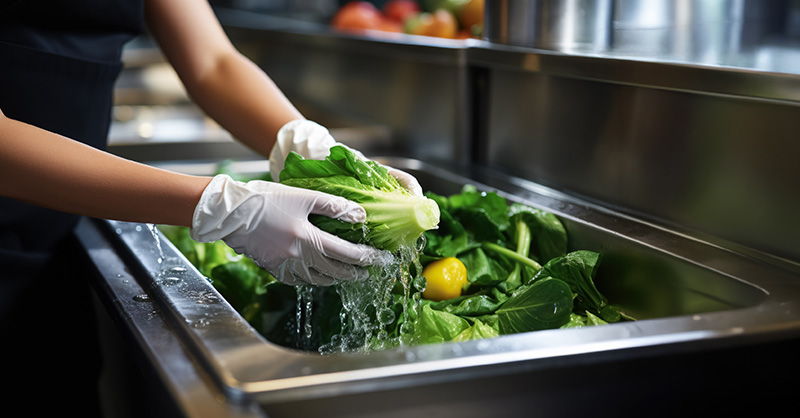Improving Food Safety in Commercial Kitchens

Maintaining a clean, safe workplace is vital for any business owner operating a commercial kitchen. Perhaps the most significant threat to a food service operation’s business continuity is food borne illness. Contaminated food purchased and consumed from your establishment could harm a customer’s health and your company’s reputation. In worst case scenarios, it can be difficult to recover from foodborne illness.
Types of Foodborne Bacteria
There are two types of foodborne bacteria: spoilage and pathogenic.
Spoilage bacteria is what causes food to “spoil” by developing an unpleasant look or smell. However, they typically do not cause illness.
Pathogenic bacteria, however, are toxins and poisons that cause foodborne illnesses. This specific type of bacteria can wreak havoc in the food industry if not handled with proper care. Since they can’t be seen, smelled, or tasted, contamination is difficult to detect, and victims are typically unaware until it’s too late.
Despite increasing awareness of the issue, the problem remains widespread. The USDA estimates ~48 million annual cases of foodborne illness (commonly referred to as “food poisoning”) resulting in ~128,000 hospitalizations and ~3,000 deaths. Common germs include Salmonella, E. coli and Toxoplasma gondii.
How to Prevent Foodborne Bacteria in Your Commercial Kitchen
Without standards of procedure in place to prevent contamination and cross-contamination, bacteria can easily develop or go unnoticed before a customer consumes it. Whether ou order your food from suppliers, shop for your own groceries or run a large restaurant, it’s important to put a plan in place to prevent contamination.
The key to prevention is having best practices in place at all stages of the food service business: purchase, storage, preparation and cooking. Below is a collection of standards that can be added to your Food Safety program to avoid or mitigate an incident:
Purchase
- When screening suppliers, look for established companies with trusted reputations, industry certifications, and a valid food safety inspection report (or equivalent). Renew certifications annually.
- Avoid produce that is pre-sliced or not refrigerated.
- Do not allow food to cool before refrigerating, especially on hot days. Take necessary extra steps to keep meats, eggs and frozen foods chilled.
- Make sure the food has not passed the “Sell By” or “Use By” date listed on the packaging.
- If a product does not have a date on it, write on the package before refrigerating or freezing it.
- Avoid damaged or leaking packaging including egg cartons, and cracked eggs.
- Place meat, poultry, seafood and eggs in plastic bags without any other foods underneath.
- Check produce for freshness and quality (avoid blemishes).
Storage
- Keep produce in a separate area of the refrigerator from meat, poultry, seafood and eggs.
- Store cans and other shelf-stable food in cool, dry places and avoid extreme temperatures.
- Set refrigerator to 40 degrees F or below, freezer, 0 degrees F or below.
- Refrigerate food within 2 hours of purchase.
- Do not remove eggs from cartons and do not wash before use.
- Do not place meat, poultry, or seafood on upper shelves where it can drip below and cross contaminate other foods.
- Inspect cans and containers to confirm no leaking, bulging, dents, rust, cracks, loose lids, foul odors, etc.
- Shelf-stable food with high acid content such as tomatoes and other fruit can be stored for 12-18 months while low-acid food like meat and vegetables can be stored for 2-5 years.
Preparation
- Wash hands for at least 20 seconds with soap and water before any food prep.
- Defrost food in the refrigerator by using cold water, or microwaving; once complete, cook immediately.
- Rinse produce under running water and dry with a clean cloth, paper towel, or salad spinner.
- Always use a clean cutting board and use separate boards for produce versus meat, poultry and seafood. Sanitize boards regularly and replace after they become worn or damaged.
- Cook meat, poultry, and seafood to safe minimum internal temperatures (use a food thermometer).
- Keep meat, poultry, and seafood warm (140 degrees F or above) between cooking and serving.
- Do not let food sit out for more than 2 hours, or more than 1 hour in air temperatures above 90 degrees F.
Sources
- https://www.fda.gov/food/buy-store-serve-safe-food/food-safety-your-kitchen
- https://www.propertycasualty360.com/2014/07/11/from-supermarket-to-table-tips-to-minimize-food-po/
- https://www.fsis.usda.gov/sites/default/files/media_file/2020-12/Kitchen-Companion.pdf
- https://www.fsis.usda.gov/sites/default/files/media_file/2021-04/at-risk-booklet.pdf









